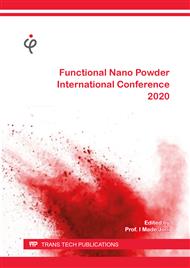[1]
Indonesian Soil Research and Agroclimate Institut, Sumber Daya Lahan Indonesia dan Pengelolaannya, Indonesian agency for Agricultural Research and Development, (2000).
Google Scholar
[2]
Arifin M., Karakterisasi Pedon Areal Pertanaman Ubi Jalar Nirkum Di Desa Cilembu, Kecamatan Tanjungsari, Kabupaten Sumedang, Propinsi Jawa Barat, Jurnal Agrikultura. 13 (2000) 110 –116.
DOI: 10.25157/ma.v7i1.4765
Google Scholar
[3]
Rachim, A.D., M. Arifin., Dasar-dasar Klasifikasi Taksonomi Tanah, Pustaka Reka Cipta, Bandung, (2011).
Google Scholar
[4]
Arifin, M., Pengaruh Abu Vulkanik Gunung Sinabung dan Batuan Fosfat Dalam Bentuk Nano Partikel Terhadap Retensi P, Delta pH, Dan Kejenuhan Basa Pada Andisol, Ciater Jawa Barat. Jur. Agroekotek 9 (2017) 75 – 85.
DOI: 10.24198/agrikultura.v28i3.15743
Google Scholar
[5]
Maryanto, A., Pengaruh Konsentrasi Pupuk Hayati Majemuk Dan Batuan Fosfat Alam Terhadap Serapan P Tanaman Selada (Lactuca sativa L) Di Tanah Andisols. J Agrovigor 3 (2010) 110-117.
DOI: 10.29244/jhi.1.2.66-73
Google Scholar
[6]
Yuliana, A., M. Arifin, Nenny, N., Pengaruh Partikel Nano Abu Vulkanik dan Batuan Fosfat Terhadap Muatan Variabel dan Kemasanan Andisol, Jurnal Agrikultura. 28 (2017) 118-125.
DOI: 10.24198/agrikultura.v28i3.15743
Google Scholar
[7]
Kauwenbergh van, S.J. Cadmium content of phosphate rocks fertilizer. In: Proceedings of the IFA technical conference, Chennai, India, 24-27 Sep 2002, pp.1-39.
Google Scholar
[8]
ISRI, Fosfat Alam Sumber Pupuk P yang Murah, Warta Penelitian dan Pengembangan Pertanian, 33 (2011) 10-12.
Google Scholar
[9]
Khan I., K. Saeed, I. Khan, Nanoparticles: Properties, applications and toxicities, Arabian Journal of Chemistry. 12 ( 2019) 908-931.
DOI: 10.1016/j.arabjc.2017.05.011
Google Scholar
[10]
Ginting, R.C., Badia, R. Saraswati, E.Husen, Mikroorganisme Pelarut Fosfat dalam Pupuk Organik dan Pupuk Hayati, Indonesian Center for Agricultural Land Resources Research and Development, Bogor, 2006. 144-146.
Google Scholar
[11]
Suciatmih, Isolasi dan Uji Pelarutan Fosfat serta Degradasi Selulosa dari Jamur Tanah Hutan Bekas Terbakar Wanariset-Semboja, Kalimantan Timur, Research Report, Bogor: Pusat Penelitian Biologi, LIPI, (2006).
DOI: 10.23869/bphjbr.13.2.20088
Google Scholar
[12]
Hanafiah, A.S., T. Sabrina, H. Guchi, Biologi dan Ekologi Tanah, Universitas Sumatera Utara, Medan, (2009).
Google Scholar
[13]
Fitriatin, B.N., A. Yuniarti., T. Turmuktini, Pegaruh Mikroba Pelarut Fosfat Penghasil Zat Pengatur Tumbuh terhadap Fosfat Tanah, Pertumbuhan dan Hasil Jagung serta Efisiensi Pupuk P pada Tanah Marginal, Research Report, Departemen of Soil Science and Land Resources, Padjadjaran University, Sumedang, (2013).
DOI: 10.24198/soilrens.v14i2.11033
Google Scholar
[14]
Suriadikarta, D.A., R.D.M. Simanungkalit, Pupuk Organik dan Pupuk Hayati, Indonesian Center for Agricultural Land Reseources Research and Development, Bogor, 2006. 1-10.
Google Scholar
[15]
Indonesian Soil Research Institute, Petunjuk Teknis Analisis Kimia Tanah, Tanaman, Air, dan Pupuk. Indonesian agency for Agricultural Research and Development, Bogor, (2009).
Google Scholar
[16]
Indonesian Center for Agricultural Land Reseources Research and Development, Metode Analisis Biologi Tanah, Indonesian agency for Agricultural Research and Development. Bogor, (2007).
Google Scholar
[17]
Hairiah, K., Widianto, Cadisch, Pengelolaan Tanah Masam Secara Biologis, ICRAF, Bogor, (2000).
Google Scholar
[18]
Suyono, A.D., T. Kurniatin, B. Joy, M. Damayani, T. Syammusa, N. Nurlaeni, A. Yuniarti, E. Trinurani, Y.T. Machmud, Kesuburan tanah dan pemupukan, RR. Print, Bandung, (2006).
Google Scholar
[19]
Kasno, A., Respon tanaman jagung terhadap pemupukan fosfor pada Typic Dystrudepts, J. Tanah Trop 14 (2009) 111-118.
DOI: 10.5400/jts.2009.v14i2.111-118
Google Scholar
[20]
Tisdale, S.L., Havlin, J.L., Beaton, J.D., Nelson, W.L., Soil fertility and fertilizers – an introduction to nutrient management, Sixth edition, Prentice-Hall, Inc. (1999).
Google Scholar
[21]
Tisdale, S.L., W.L. Nelson, I.D. Beaton, Soil Fertility and Fertilizers, Mac Millan Publiser, London, (1990).
Google Scholar


